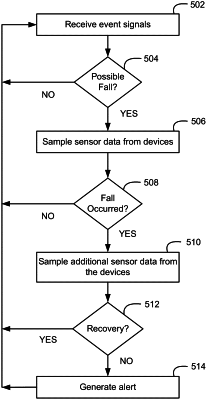| CPC A61B 5/1117 (2013.01) [A61B 5/0022 (2013.01); A61B 5/0024 (2013.01); G08B 21/02 (2013.01); G08B 21/0446 (2013.01); G08B 25/10 (2013.01); G08B 21/043 (2013.01)] | 20 Claims |

|
1. A smart monitoring system, the system comprising:
a processor; and
a memory having executable instructions stored thereon that when executed by the processor cause the processor to:
receive event signals from a first accelerometer that is configured to measure activity values corresponding to movements of a person;
receive a location signal from an individual location sensor that is configured to measure a location of the person;
identify a possible fall event based on activity values included in the event signals received from the first accelerometer exceeding a threshold;
identify a current location of the person based on the location signal received from the individual location sensor;
sample first sensor data from the first accelerometer based on the activity values exceeding the threshold, the first sensor data including values representative of measurements of movement associated with the possible fall event;
determine that a fall has occurred to the person based on the sampled first sensor data;
sample second sensor data from a second accelerometer for additional motion at a period of time subsequent to the fall based on the determination that a fall has occurred, the second accelerometer being selected based on the identified current location of the person, the additional motion comprising a sustained increase in an amplitude of movement;
determine a presence of recovery from the fall based on the second sensor data including the additional motion; and
generate trends associated with health and safety conditions including behaviors in mobility based on the determination of the fall, the presence of recovery, and the event signals.
|